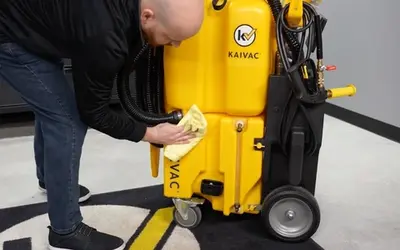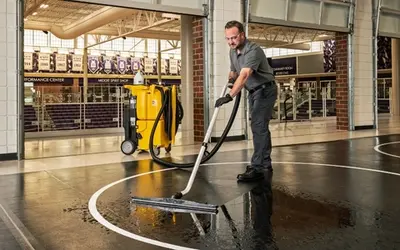The Importance of Deep Cleaning

Project cleaning, deep cleaning, or spring cleaning, no matter what you call it, these yearly tasks protect your facility. Deep cleaning projects extend the life of building materials, safeguard mechanical systems, and create healthier interiors. They are also resource-intensive, requiring extra tools, time, and people to complete the work.
This year, with so many cleaning operations being impacted by the great labor shortage, it seems tempting to defer these projects for a few months or even a few years. While that may save in the short term, this strategy only leads to bigger, more expensive projects in the future.
Here’s how deep cleaning saves resources in the long run and how to communicate that fact your managers.
The Cost of Deferred Maintenance
“The ideal maintenance program is a proactive one,” writes James Piper, P.E. in an article published in Building Operating Management. Unfortunately, years of shrinking maintenance budgets have forced many facility managers and building owners to defer maintenance. They kick projects down the road until funding becomes available or a critical piece of building infrastructure fails.
Deferred maintenance like this is supposed to save money. Unsurprisingly, it ends up costing a lot more. That price tag only grows as the delay stretches on. Piper estimates that on average, for every dollar “saved” by deferring maintenance, there comes a four dollar increase in future capital renewal costs. He adds that there are also indirect costs that can total more than 15 times the price tag of the original project.
Conversely, proactive maintenance stretches the life of a building and saves money in the long run. This theory applies to every part of the structure, from the roof and exterior paint to systems like electrical, hot water, and HVAC to interior fixtures and finishes.
Make the Case for Proactive Maintenance
Lack of resources, either money or staff, remains the main reason for deferred maintenance. That means you need to build a strong argument to win the resources you need for proactive maintenance projects. Naomi Millán offered some great tips on how to sway decision makers in this article published on Facilities.net. She suggests that you:
- Talk about the increased liability risk and safety hazards of deferred maintenance. Also mention decreasing productivity levels impacted building operations.
- Bring the math that shows the actual cost of a deferred maintenance project. Calculate potential replacement costs and focus on the savings of doing the work today.
- Illustrate your point with examples from the past. Find past cases where deferred maintenance resulted in significant costs down the road.
Making the Case for Deep Cleaning Projects
Obviously, Kaivac cannot help with every aspect of proactive maintenance. However, our expertise in restrooms, hard surface floors, and touchpoints will help you avoid the heavy costs of deferred maintenance in these areas. Here are some questions to ask when building a case for deep cleaning projects in these critical areas.
Restrooms
- How often do I need to reseal grouted floors?
- How often do I need to regrout tiled floors?
- Are there more advanced ways to care for tile and grout floors?
Hard Surface Floors
- Am I doing annual top scrubs?
- Is it time to strip and refinish?
- Is there a better way to strip and refinish hard surface floors?
Touchpoints
- Am I hitting touchpoints frequently enough?
- Are there other, less common touchpoints that need attention?
- What are some good touchpoint cleaning tools?
Deep cleaning projects are an important part of proactive maintenance. Thorough regular cleaning of critical spaces will also go a long way in extending your facility’s useful life. Contact us to learn more about advanced tools from Kaivac. We can help you maintain restrooms, hard surface floors, and touchpoints to the highest standards while saving time, effort, and resources.
Related Posts

Preventive Maintenance for Your No-Touch Cleaning® System
Your Kaivac No-Touch Cleaning system makes restroom maintenance fast and easy. Keeping your No-Touch Cleaning system in good working order is also fast and easy. Kaivac makes performing preventative maintenance and troubleshooting potential issues simple. No special equipment or technical expertise required.
Read more
A Cleaning Lesson from Schools and Universities that Rely on Kaivac Systems
School, college, and university facilities departments from around the country love their Kaivac Cleaning Systems. Why wouldn’t they? Designed with the custodial worker in mind, these tools and processes from Kaivac are easy to master, work super-fast, and deliver exceptionally clean, fresh-smelling spaces.
Read more
Reduce Absenteeism Through Better School Cleaning
K-12 school leaders are coming up with a variety of ways to combat chronic absenteeism. Strategies like offering in-school laundry services and basic health care show a lot of promise. But providing better cleaning may be one of the most effective, most cost-efficient tactics available.
Read more